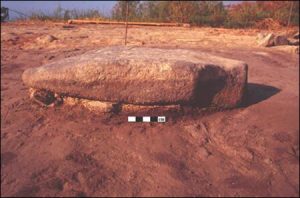
I have written before about the great Colin Tudge, who rejects the idea that agriculture began in the Middle East 10,000 years ago. In Neanderthals, Bandits and Farmers: How Agriculture Really Began, he reasons that hunter-gatherers had been enjoying farming for 30,000 years before the large fields were laid out and planted with mono-crops for Mesopotamian cities. Not that these Paleolithic humans farmed full time, hunting and gathering has always been a practice of humans, if wildlands are available. Of course, the critics attacked him, and said he was indulging theory without evidence.
I accepted Tudge’s idea immediately. Gatherers are out working with plants all the time. The drawing above is a facial reconstruction of a hunter-gatherer woman. link She looks just like the kind of intelligent and thoughtful “gatherer” who is going to clear brush away from a berry bush to help it along until her return. Seed heads are easy to see and sowing a handful of ripe seeds from some valuable herb or vegetable seems a reasonable proposition for her survival and the survival of her Paleolithic ancestors.
The idea also conforms to my personal experience. At a recent gardening lecture I learned that small branches of fruit trees will root if stuck into the ground and conditions favor them; I’ll try this advice very soon. Another example? I thought the 17 degree weather last winter had killed my Pomegranate bush and I put its removal on my to-do list. Its long stickers and my indolence left it sitting in the back garden and I found it thriving during my fall cleanup this past week. I put in my cauliflower too late last spring and it did not bear but the big plants looked nice and I left them in place all summer. After months of 100 degree days the bushes appear to be making cauliflowers in the fall weather–contrary to all respectable gardening practices.
Plants just want to do well and helping them is natural- polite. It seems impossible to me that my Paleolithic counterpart or the beautiful Neolithic woman pictured above– who lived about 9000 years ago– would not pull all the grass and grapevines away from the Pomegranate as I did. Or put fruit and berry stems into the ground to extend production. It seems obvious to me that gatherers farmed.
And, it turns out Tudge is being proven right. Research by scientists has revealed “farming’ in tropical forests about 30,000 years before the Mesopotamian miracle. link
Critics and some of my learned friends complain that the word farming and/or agriculture mean something specific; and that specific thing originated 10,000 years ago in the Middle East. It’s in the textbooks; it’s just true. As is the ‘discovery’ of the American continents by Columbus. That idea was considered true in every textbook I ever read in school. Who was the first person to ask, “How can you discover a place where at least 50 million people are already living?” So we get stuck talking about words and their meaning. “Discover” is now “interpreted”; it just doesn’t mean what it meant for 500+ years. “Agriculture” may not mean the Middle East model much longer
Archaeologists Patrick Roberts, Damian Evans and other scientists have used genetic sampling of forest ecosystems, isotope analysis of human teeth and soil analysis to describe 40,000 year old cities and farms in the equatorial rain forests. These modern scientists have determined humans burned forestland to make room for plants to eat and homes to live in. Very complicated soils were mixed to grow plants, swamps were drained, chickens and other animals domesticated and yams, taro, sweet potatoes, chili peppers, black peppers, mangoes, and bananas were grown. Ancient agriculture practices were revealed to be a pattern across equatorial Africa, South Asia, and Southeast Asia. link
Transplantation and cultivation extend back to the Holocene. New Guinea has provided some of the earliest evidence at a location called Kuk Swamp where humans emigrated and brought yams, bananas and taro with them for planting. In the Carribbean and Polynesia, evidence has emerged of the importation of plants like wild avocado and manioc by ancient travelers. link
Researchers from the Tel Aviv University, Harvard and other prominent schools have found evidence that plant cultivation was begun 23,000 years ago by the Ohalo II people who lived near the Sea of Galilee. These early humans used 140 species of plants, including cereals like wild emmer, wild barley, and wild oats. The Ohalo people had sickle blades to harvest the grain and used the grinding stone pictured here to process their grains. There seems to be much fear of the 10,000-year dogma about the beginning of agriculture. They seem to belabor their case that the Ohalo people had knowledge of agriculture and had foresight – so that they could practice ‘agricultural planning’. link I’m pretty sure foresight was in existence before the Mesopotamians turned to agriculture.
There seems to be much fear of the 10,000-year dogma about the beginning of agriculture. They seem to belabor their case that the Ohalo people had knowledge of agriculture and had foresight – so that they could practice ‘agricultural planning’. link I’m pretty sure foresight was in existence before the Mesopotamians turned to agriculture.
The 10,000 year dogma packs such power that earlier farming is called proto-farming even by Tudge. Proto is often used to describe a language that preceded another language, proto-Slavic, for example. It means pre. Which makes me think of George Carlin who made fun of the airlines when they announce that it is time for people with children to pre-board. “What do they mean?” he asks. “Why can’t they just board. Is the airline asking that they board before they board?”
Are researchers and scientists asking us to imagine that Paleolithic humans were pre-farming? Farming before they farmed?